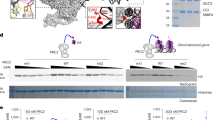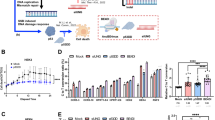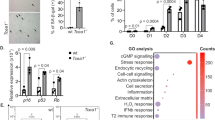Abstract
The genetic instability driving tumorigenesis is fuelled by DNA damage and by errors made by the DNA replication. Upon DNA damage the cell organizes an integrated response not only by the classical DNA repair mechanisms but also involving mechanisms of replication, transcription, chromatin structure dynamics, cell cycle progression, and apoptosis. In the present study, we investigated the role of p19INK4d in the response driven by neuroblastoma cells against DNA injury caused by UV irradiation. We show that p19INK4d is the only INK4 protein whose expression is induced by UV light in neuroblastoma cells. Furthermore, p19INK4d translocation from cytoplasm to nucleus is observed after UV irradiation. Ectopic expression of p19INK4d clearly reduces the UV-induced apoptosis as well as enhances the cellular ability to repair the damaged DNA. It is clearly shown that DNA repair is the main target of p19INK4d effect and that diminished apoptosis is a downstream event. Importantly, experiments performed with CDK4 mutants suggest that these p19INK4d effects would be independent of its role as a cell cycle checkpoint gene. The results presented herein uncover a new role of p19INK4d as regulator of DNA-damage-induced apoptosis and suggest that it protects cells from undergoing apoptosis by allowing a more efficient DNA repair. We propose that, in addition to its role as cell cycle inhibitor, p19INK4d is involved in maintenance of DNA integrity and, therefore, would contribute to cancer prevention.
This is a preview of subscription content, access via your institution
Access options
Subscribe to this journal
Receive 50 print issues and online access
$259.00 per year
only $5.18 per issue
Buy this article
- Purchase on Springer Link
- Instant access to full article PDF
Prices may be subject to local taxes which are calculated during checkout










Similar content being viewed by others
References
Al-Mohanna MA, Manogaran PS, Al-Mukhalafi Z, Al-Hussein KA and Aboussekhra A . (2004). Oncogene, 23, 201–212.
Bai F, Pei XH, Godfrey VL and Xiong Y . (2003). Mol. Cell. Biol., 23, 1269–1277.
Barret JM, Cadou M and Hill BT . (2002). Biochem. Pharmacol., 63, 251–258.
Bernstein C, Bernstein H, Payne CM and Garewal H . (2002). Mutat. Res., 511, 145–178.
Chan FK, Zhang J, Cheng L, Shapiro DN and Winoto A . (1995). Mol. Cell. Biol., 15, 2682–2688.
Chaussade L, Eymin B, Brambilla E and Gazzeri S . (2001). Oncogene, 20, 6587–6596.
Cheng M, Olivier P, Diehl JA, Fero M, Roussel MF, Roberts JM and Sherr CJ . (1999). EMBO J., 18, 1571–1583.
Chomczynski P and Sacchi N . (1987). Anal. Biochem., 162, 156–159.
Connor B and Dragunow M . (1998). Brain Res. Brain Res. Rev., 27, 1–39.
Cunningham JJ and Roussel MF . (2001). Cell Growth Differ., 12, 387–396.
Dingwall C and Laskey RA . (1991). Trends Biochem. Sci., 16, 478–481.
Dunkern TR, Fritz G and Kaina B . (2001). Oncogene, 20, 6026–6038.
Dyson N . (1998). Genes. Dev., 12, 2245–2262.
Fan C, Yang J and Engelhardt JF . (2002). J. Cell Sci., 115, 4843–4853.
Friedberg EC . (2001). Nat. Rev. Cancer, 1, 22–33.
Guan KL, Jenkins CW, Li Y, O'Keefe CL, Noh S, Wu X, Zariwala M, Matera AG and Xiong Y . (1996). Mol. Biol. Cell., 7, 57–70.
Hahn WC and Weinberg RA . (2002). Nat. Rev. Cancer, 2, 331–341.
Harper JW and Elledge SJ . (1996). Curr. Opin. Genet. Dev., 6, 56–64.
Hengst L and Reed SI . (1998). Curr. Top. Microbiol. Immunol., 227, 25–41.
Hirai H, Roussel MF, Kato JY, Ashmun RA and Sherr CJ . (1995). Mol. Cell. Biol., 15, 2672–2681.
Hoeijmakers JH . (2001). Nature, 411, 366–374.
Hosoi G, Hara J, Okamura T, Osugi Y, Ishihara S, Fukuzawa M, Okada A, Okada S and Tawa A . (1994). Cancer, 73, 3087–3093.
Igney FH and Krammer PH . (2002). Nat. Rev. Cancer, 2, 277–288.
Johnstone RW, Ruefli AA and Lowe SW . (2002). Cell, 108, 153–164.
Lengauer C, Kinzler KW and Vogelstein B . (1998). Nature, 396, 643–649.
Lim MA, Kikani CK, Wick MJ and Dong LQ . (2003). Proc. Natl. Acad. Sci. USA, 100, 14006–14011.
Lukas J, Parry D, Aagaard L, Mann DJ, Bartkova J, Strauss M, Peters G and Bartek J . (1995). Nature, 375, 503–506.
Lutzen A, Bisgaard HC and Rasmussen LJ . (2004). Exp. Cell Res., 292, 123–134.
Malumbres M and Barbacid M . (2001). Nat. Rev. Cancer, 1, 222–231.
Martin GS . (2003). Cancer Cell., 4, 167–174.
Matsuzaki Y, Miyazawa K, Yokota T, Hitomi T, Yamagishi H and Sakai T . (2002). FEBS Lett., 517, 272–276.
Mattaj IW and Englmeier L . (1998). Annu. Rev. Biochem., 67, 265–306.
Milligan A, Gabrielli BG, Clark JM, Hayward NK and Ellem KA . (1998). Mutat. Res., 422, 43–53.
Minella AC, Swanger J, Bryant E, Welcker M, Hwang H and Clurman BE . (2002). Curr. Biol., 12, 1817–1827.
Miyamoto Y, Saiwaki T, Yamashita J, Yasuda Y, Kotera I, Shibata S, Shigeta M, Hiraoka Y, Haraguchi T and Yoneda Y . (2004). J. Cell. Biol., 165, 617–623.
Murray AW . (2004). Cell, 116, 221–234.
Nakayama K . (1998). Bioessays, 20, 1020–1029.
Nayak BK and Das GM . (2002). Oncogene, 21, 7226–7229.
Newton Bishop JA, Harland M, Bennett DC, Bataille V, Goldstein AM, Tucker MA, Ponder BA, Cuzick J, Selby P and Bishop DT . (1999). Br. J. Cancer, 80, 295–300.
Norbury CJ and Zhivotovsky B . (2004). Oncogene, 23, 2797–2808.
Ortega S, Malumbres M and Barbacid M . (2002). Biochim. Biophys. Acta., 1602, 73–87.
Park DS, Morris EJ, Padmanabhan J, Shelanski ML, Geller HM and Greene LA . (1998). J. Cell Biol., 143, 457–467.
Rittie L and Fisher GJ . (2002). Ageing Res. Rev., 1, 705–720.
Roussel MF . (1999). Oncogene, 18, 5311–5317.
Ruas M and Peters G . (1998). Biochim. Biophys. Acta., 1378, F115–F177.
Rubbi CP and Milner J . (2003). EMBO J., 22, 975–986.
Sadee W, Yu VC, Richards ML, Preis PN, Schwab MR, Brodsky FM and Biedler JL . (1987). Cancer Res., 47, 5207–5212.
Sancar A, Lindsey-Boltz LA, Unsal-Kaccmaz K and Linn S . (2004). Annu. Rev. Biochem., 73, 39–85.
Sandal T . (2002). Oncologist, 7, 73–81.
Scassa ME, Guberman AS, Ceruti JM and Canepa ET . (2004). J. Biol. Chem., 279, 28082–28092.
Serrano M . (1997). Exp. Cell. Res., 237, 7–13.
Shapiro GI, Edwards CD, Ewen ME and Rollins BJ . (1998). Mol. Cell. Biol., 18, 378–387.
Sharpless NE, Bardeesy N, Lee KH, Carrasco D, Castrillon DH, Aguirre AJ, Wu EA, Horner JW and DePinho RA . (2001). Nature, 413, 86–91.
Sharpless NE, Ramsey MR, Balasubramanian P, Castrillon DH and DePinho RA . (2004). Oncogene, 23, 379–385.
Sherr CJ . (2004). Cell, 116, 235–246.
Sherr CJ and Roberts JM . (1999). Genes Dev., 13, 1501–1512.
Sotillo R, Dubus P, Martin J, de la Cueva E, Ortega S, Malumbres M and Barbacid M . (2001). EMBO J., 20, 6637–6647.
Sun Y, Yuan J, Liu H, Shi Z, Baker K, Vuori K, Wu J and Feng GS . (2004). Mol. Cell. Biol., 24, 1531–1539.
Thullberg M, Bartek J and Lukas J . (2000). Oncogene, 19, 2870–2876.
Trimarchi JM and Lees JA . (2002). Nat. Rev. Mol. Cell Biol., 3, 11–20.
Varone CL, Giono LE, Ochoa A, Zakin MM and Canepa ET . (1999). Arch. Biochem. Biophys., 372, 261–270.
Wang G, Reed E and Li QQ . (2004). Oncol. Rep., 12, 955–965.
Wilson AJ, Arango D, Mariadason JM, Heerdt BG and Augenlicht LH . (2003). Cancer Res., 63, 5401–5407.
Wu S, Tan M, Hu Y, Wang JL, Scheuner D and Kaufman RJ . (2004). J. Biol. Chem., 279, 34898–34902.
Yokota T, Matsuzaki Y, Miyazawa K, Zindy F, Roussel MF and Sakai T . (2004). Oncogene, 23, 5340–5349.
Yuan J and Yankner BA . (2000). Nature, 407, 802–809.
Zindy F, Cunningham JJ, Sherr CJ, Jogal S, Smeyne RJ and Roussel MF . (1999). Proc. Natl. Acad. Sci. USA, 96, 13462–13467.
Zindy F, Quelle DE, Roussel MF and Sherr CJ . (1997a). Oncogene, 15, 203–211.
Zindy F, Soares H, Herzog KH, Morgan J, Sherr CJ and Roussel MF . (1997b). Cell. Growth Differ., 8, 1139–1150.
Acknowledgements
This work was supported by research grants from Ministerio de Salud de la Nación (Beca Carrillo-Oñativia) and Agencia Nacional de Promoción Científica y Tecnológica. JC is a Graduate Fellow and CV and EC are researcher members of Consejo Nacional de Investigaciones Científicas y Técnicas (CONICET).
Author information
Authors and Affiliations
Corresponding author
Rights and permissions
About this article
Cite this article
Ceruti, J., Scassa, M., Fló, J. et al. Induction of p19INK4d in response to ultraviolet light improves DNA repair and confers resistance to apoptosis in neuroblastoma cells. Oncogene 24, 4065–4080 (2005). https://doi.org/10.1038/sj.onc.1208570
Received:
Revised:
Accepted:
Published:
Issue Date:
DOI: https://doi.org/10.1038/sj.onc.1208570
Keywords
This article is cited by
-
BOK promotes chemical-induced hepatocarcinogenesis in mice
Cell Death & Differentiation (2018)
-
Oxidative stress-induced CREB upregulation promotes DNA damage repair prior to neuronal cell death protection
Molecular and Cellular Biochemistry (2017)
-
Differential response of normal and malignant urothelial cells to CHK1 and ATM inhibitors
Oncogene (2015)
-
Nuclear translocation of p19INK4d in response to oxidative DNA damage promotes chromatin relaxation
Molecular and Cellular Biochemistry (2015)
-
E2F1 induces p19INK4d, a protein involved in the DNA damage response, following UV irradiation
Molecular and Cellular Biochemistry (2012)



